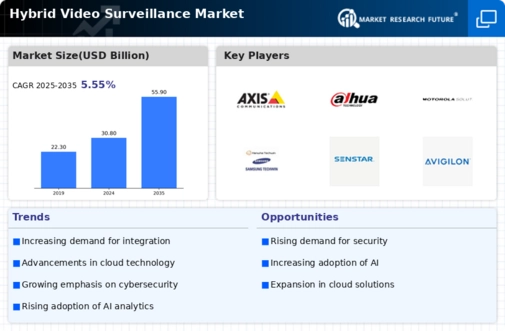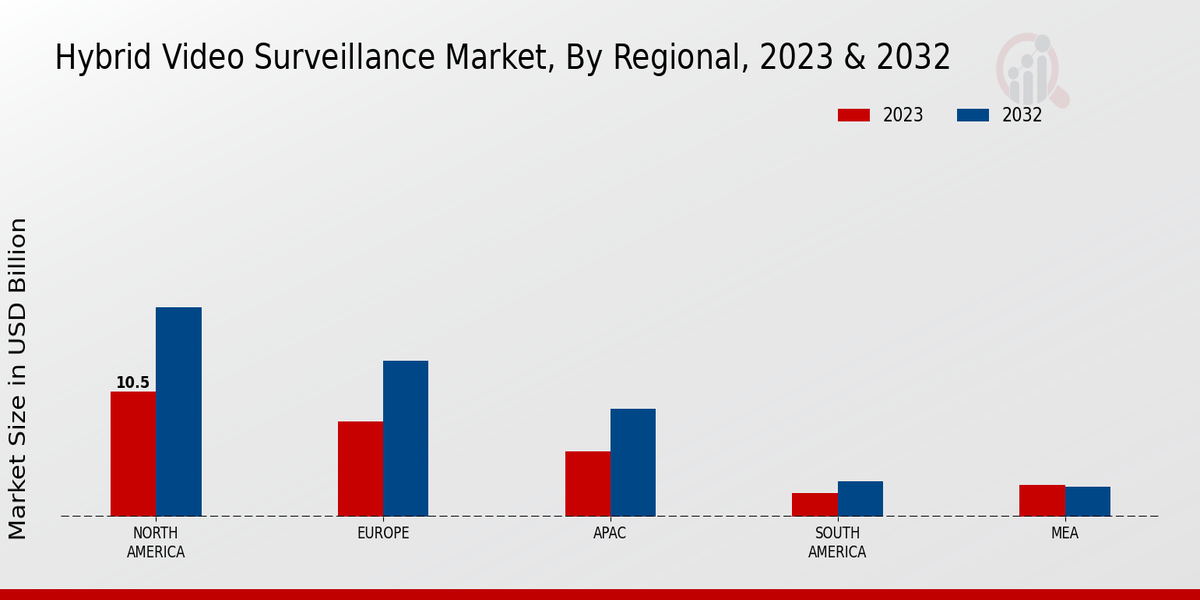Market Growth Projections
The Global Hybrid Video Surveillance Market Industry is poised for substantial growth, with projections indicating a market size of 30.8 USD Billion in 2024 and an anticipated increase to 55.9 USD Billion by 2035. This growth reflects a compound annual growth rate (CAGR) of 5.55% from 2025 to 2035, driven by various factors including technological advancements, increasing security concerns, and regulatory compliance. The market dynamics suggest a robust demand for hybrid solutions that integrate traditional and modern surveillance technologies, catering to diverse sectors such as retail, transportation, and public safety.
Integration of AI and Analytics
The integration of artificial intelligence and advanced analytics into hybrid video surveillance systems is transforming the Global Hybrid Video Surveillance Market Industry. AI technologies enable real-time data analysis, enhancing threat detection and response capabilities. For example, facial recognition and behavior analysis can identify suspicious activities, allowing for proactive measures. This technological advancement not only improves security but also optimizes resource allocation. As organizations recognize the value of AI-driven insights, the market is anticipated to grow, with a projected CAGR of 5.55% from 2025 to 2035. This integration signifies a shift towards more intelligent surveillance solutions.
Regulatory Compliance and Standards
The necessity for compliance with regulatory standards is a significant driver of the Global Hybrid Video Surveillance Market Industry. Governments worldwide are implementing stringent regulations regarding data protection and privacy, compelling organizations to adopt hybrid surveillance solutions that ensure compliance. For example, the General Data Protection Regulation (GDPR) in Europe mandates strict guidelines for video surveillance practices. Organizations are increasingly turning to hybrid systems that offer enhanced data management capabilities to meet these requirements. This compliance-driven approach is likely to propel market growth as businesses seek to avoid penalties and maintain consumer trust.
Growing Demand for Enhanced Security
The increasing need for enhanced security solutions across various sectors drives the Global Hybrid Video Surveillance Market Industry. Organizations are increasingly adopting hybrid systems that combine traditional analog cameras with advanced IP technology, providing a more comprehensive security solution. This trend is particularly evident in urban areas where crime rates are higher. For instance, cities are investing in hybrid systems to monitor public spaces effectively. The market is projected to reach 30.8 USD Billion in 2024, reflecting the urgency for improved surveillance capabilities. As security concerns escalate, the demand for hybrid video surveillance solutions is expected to rise significantly.
Rising Adoption in Retail and Commercial Sectors
The retail and commercial sectors are increasingly adopting hybrid video surveillance systems to enhance security and operational efficiency, significantly impacting the Global Hybrid Video Surveillance Market Industry. Retailers utilize these systems to monitor customer behavior, prevent theft, and improve overall store management. For instance, hybrid systems allow for the integration of point-of-sale data with video feeds, providing valuable insights into consumer trends. As the retail landscape evolves, the demand for sophisticated surveillance solutions is expected to grow, contributing to the market's expansion. This trend underscores the importance of hybrid systems in modern retail environments.
Increasing Urbanization and Infrastructure Development
Rapid urbanization and infrastructure development are pivotal factors influencing the Global Hybrid Video Surveillance Market Industry. As cities expand, the need for effective surveillance systems to monitor public safety and manage traffic flows becomes paramount. Governments are investing in smart city initiatives that incorporate hybrid video surveillance to enhance urban management. For instance, cities are deploying hybrid systems in transportation hubs and public spaces to ensure safety and efficiency. This trend is expected to contribute to the market's growth, with projections indicating a rise to 55.9 USD Billion by 2035, highlighting the critical role of surveillance in urban environments.
























Leave a Comment